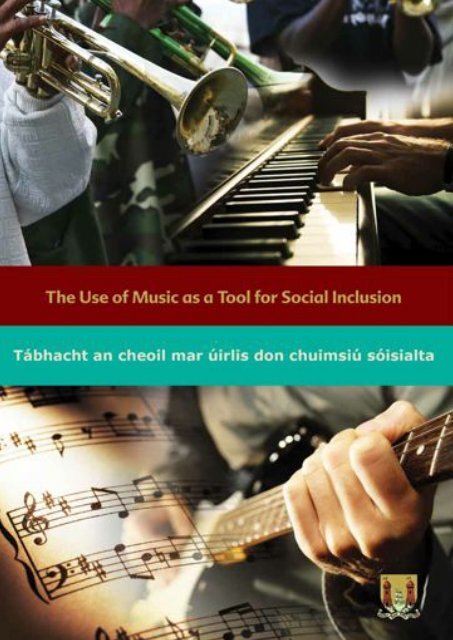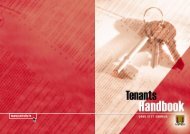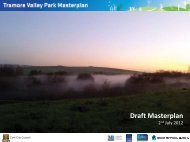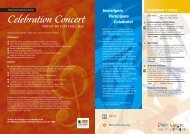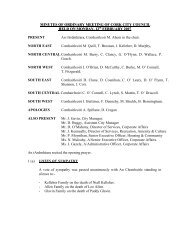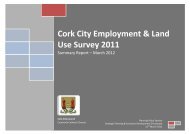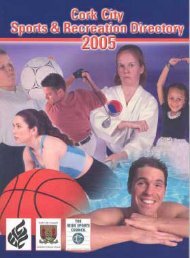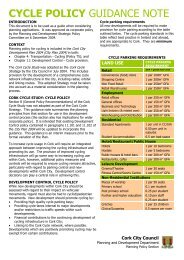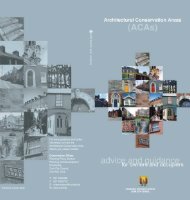Music as a Tool for Social Inclusion (PDF) - Cork City Council
Music as a Tool for Social Inclusion (PDF) - Cork City Council
Music as a Tool for Social Inclusion (PDF) - Cork City Council
You also want an ePaper? Increase the reach of your titles
YUMPU automatically turns print PDFs into web optimized ePapers that Google loves.
The Use of <strong>Music</strong> <strong>as</strong> a <strong>Tool</strong> <strong>for</strong> <strong>Social</strong> <strong>Inclusion</strong><br />
2009<br />
<strong>Cork</strong> <strong>City</strong> <strong>Council</strong>
ISBN No: 9780902282124<br />
Published by <strong>Cork</strong> <strong>City</strong> <strong>Council</strong> in 2009<br />
Research project w<strong>as</strong> coordinated and edited by<br />
Maria Minguella and Cathy Buchanan, and<br />
carried out independently by<br />
UONER Ltd. Company.<br />
Copyright © <strong>Cork</strong> <strong>City</strong> <strong>Council</strong>
Dedication<br />
This report is dedicated to the workers and volunteers who bring music into <strong>Cork</strong>’s communities,<br />
to whom the residents of the city owe a debt of gratitude. Bob Seward should be singled out <strong>as</strong><br />
a pioneer in providing quality music education to disadvantaged communities on the northside<br />
of the city; so should Sean Forde, who h<strong>as</strong> done the same on the southside.
Foreword<br />
I welcome the publication of “The Use of <strong>Music</strong> <strong>as</strong> a <strong>Tool</strong> <strong>for</strong> <strong>Social</strong> <strong>Inclusion</strong>”, b<strong>as</strong>ed on the work<br />
of community music organisations in disadvantaged are<strong>as</strong> of <strong>Cork</strong> <strong>City</strong>.<br />
<strong>Cork</strong> <strong>City</strong> <strong>Council</strong> <strong>Social</strong> <strong>Inclusion</strong> Unit initiated and led this research with the support of the<br />
!"##$%&'()#$*&!)+,"$-*).%/)0",1)0&'()0"$%!&23*)4,'*)567!89)):');.*),8!"+%&*8/)'
Réamhrá<br />
Fearaim fáilte roimh foilsiú “Úsáid Cheoil mar Uirlis don Cuimsiú Sóisialta” atá bunaithe ar obair<br />
na neagraíochtaí cheoil pobal ‘sna ceantair míbhuntáistiúla.<br />
B’é an tAonad Cuimsiú Sóisialta de chuid Comhairle Cathrach Chorcaí a chur an taighde seo<br />
.,).+
Contents<br />
Executive Summary<br />
Introduction<br />
Section 1: Policy Context<br />
1.1. Introduction<br />
1.2. <strong>Social</strong> <strong>Inclusion</strong><br />
1.3. The European <strong>Social</strong> Agenda – Lisbon, 2000<br />
1.4. Ireland’s NAPinclusion 2007 – 2016<br />
1.5. Employment and Education<br />
1.6. Adult Learning and Community Education<br />
1.7. Lifelong Learning and Active Citizenship<br />
1.8. The Arts and <strong>Social</strong> <strong>Inclusion</strong><br />
1.9. <strong>Music</strong> Education<br />
Local <strong>Music</strong> Services<br />
Primary and Secondary Level <strong>Music</strong><br />
Third Level <strong>Music</strong> Education<br />
1.10. <strong>Cork</strong> <strong>City</strong> Learning Forum<br />
Forum Operating Structures<br />
Steering Committee<br />
Forum Plenary Meetings and Working Groups<br />
1.11. Summary<br />
1.12. Conclusion<br />
1<br />
4<br />
6<br />
7<br />
7<br />
9<br />
9<br />
10<br />
12<br />
13<br />
14<br />
15<br />
15<br />
16<br />
16<br />
17<br />
17<br />
17<br />
18<br />
18<br />
19<br />
Section 2: Local <strong>Music</strong> Education Services in <strong>Cork</strong> <strong>City</strong><br />
2.1. Introduction and Approach<br />
2.2. The Questionnaire<br />
2.3. Overview of Participation<br />
M9N9)))O,"728)"6)O.,'&!&-.%'*<br />
2.5. Membershipb<strong>as</strong>ed Groups<br />
2.6. Community <strong>Music</strong> Education Providers<br />
2.7. Fulltime Programmes<br />
2.8. Progression from Fulltime Programmes<br />
2.9. Parttime Programmes<br />
2.10. Outreach Programmes<br />
2.11. Conclusion<br />
20<br />
21<br />
22<br />
22<br />
23<br />
24<br />
25<br />
25<br />
26<br />
27<br />
28<br />
29<br />
Section 3: Sustainability Assessment<br />
3.1. Introduction and Methods of Assessing Sustainability<br />
3.2. Organisational Structures and Systems<br />
3.3. Resources: facilities, income and expenditure<br />
Facilities<br />
Income and Expenditure<br />
Types of Income<br />
Grant Income<br />
Fundraising<br />
Fees<br />
Income Summary<br />
Expenditure<br />
30<br />
31<br />
32<br />
32<br />
32<br />
33<br />
33<br />
34<br />
35<br />
35<br />
35<br />
35
3.4. People<br />
Volunteers<br />
Human Resources<br />
3.5. Process<br />
Events<br />
Partnership<br />
Networking<br />
3.6. Conclusion<br />
36<br />
37<br />
37<br />
38<br />
38<br />
38<br />
39<br />
39<br />
Section 4: Inclusiveness and Sustainability of Services<br />
4.1. Are community music education services inclusive?<br />
Education<br />
Employment<br />
Personal Development Outcomes<br />
Concluding Remarks<br />
4.2. Are community music education services sustainable?<br />
Impact of Fundraising<br />
Community <strong>Music</strong> Education Centres<br />
Member Groups<br />
Parttime and Outreach programmes<br />
Parttime Programmes<br />
Outreach Programmes<br />
Financial Sustainability: Concluding Remarks<br />
Shortterm Programme Focus and Educational Outcomes from<br />
Employment Programmes<br />
People<br />
Process<br />
40<br />
41<br />
42<br />
42<br />
42<br />
44<br />
44<br />
45<br />
46<br />
47<br />
47<br />
47<br />
48<br />
48<br />
49<br />
49<br />
50<br />
Section 5: Community <strong>Music</strong> Organisations in <strong>Cork</strong> <strong>City</strong> 2006 to 2009<br />
5.1. Introduction<br />
5.2. <strong>Cork</strong> Community <strong>Music</strong> Network<br />
5.3. <strong>Cork</strong> Community <strong>Music</strong> Organisations<br />
<strong>Cork</strong> Academy of <strong>Music</strong><br />
Togher <strong>Music</strong> Project and School<br />
Barrack Street Band<br />
Butter Exchange Band<br />
<strong>Cork</strong> <strong>Music</strong> Works<br />
Voices of <strong>Cork</strong><br />
<strong>Cork</strong>’s Children Chorus<br />
Pipe Bands<br />
52<br />
53<br />
53<br />
54<br />
54<br />
55<br />
55<br />
55<br />
56<br />
56<br />
56<br />
56<br />
Section 6: Conclusion and Recommendations<br />
6.1. Conclusion<br />
6.2. Key Recommendations<br />
58<br />
59<br />
60<br />
Appendix 1:<br />
Description of the community music organisations and groups<br />
63
Executive Summary<br />
<strong>Cork</strong> <strong>City</strong>’s communities have a long tradition of musicmaking, best illustrated by the<br />
level of local respect <strong>for</strong> the “Barracka” and the “Buttera” the <strong>Cork</strong> Barrack Street<br />
Band and the Butter Exchange Band, which have been around since 1837 and 1878<br />
respectively. There are many other community music initiatives in the city. These<br />
include fulltime music education programmes offered by the <strong>Cork</strong> Academy of <strong>Music</strong><br />
and the Togher <strong>Music</strong> Project, choirs, pipe bands, br<strong>as</strong>s bands and school outreach<br />
services.<br />
The purpose of this report w<strong>as</strong> to identify how national polices, national and local<br />
,8*8.,!) .%/) 2"!.2) *',$!'$,8*>) !.%) '"+8'
The Use of <strong>Music</strong> <strong>as</strong> a <strong>Tool</strong> <strong>for</strong> <strong>Social</strong> <strong>Inclusion</strong><br />
Executive Summary<br />
The research shows that the work of the local music groups meets national and local<br />
-"2&!&8*>) (8') '
The Use of <strong>Music</strong> <strong>as</strong> a <strong>Tool</strong> <strong>for</strong> <strong>Social</strong> <strong>Inclusion</strong><br />
Executive Summary<br />
than music to cover almost 20% of their expenses. A portion of those<br />
expenses are incurred in providing outreach services to schools <strong>as</strong> part<br />
of the state music education curriculum. One of the two outreach<br />
programmes to schools had to ce<strong>as</strong>e in 2008 because of lack of funding.<br />
) J',.'8+&!)-2.%%&%+)&*)8Y',8#82()/&67!$2')&%)'
1.Introduction<br />
<strong>Cork</strong> <strong>City</strong>’s communities have a long tradition of musicmaking. In<strong>for</strong>mally or <strong>for</strong>mally,<br />
at home, in pubs and halls, in bands at street processions and concert per<strong>for</strong>mances,<br />
1<br />
music h<strong>as</strong> very much had its place. Ireland’s “oldest amateur musical institution” the<br />
Barrack Street Band, started at the city end of that southside street in 1837, and<br />
its contemporary counterpart on the northside, the Butter Exchange Band, began<br />
alongside the thenthriving local butter market at Shandon in 1878.<br />
The origins of the Barrack Street Band are linked to ef<strong>for</strong>ts to tackle the misery of the<br />
2<br />
socioeconomic conditions of the time through the Temperance Movement. As then, so<br />
now: the opportunities that can be opened up to disadvantaged communities through<br />
music and musicmaking remain determinedly alive in the city. The aim of this report is<br />
to highlight the work of the people who make it so.<br />
This research report seeks to analyse how and if the learning of music can be used <strong>as</strong><br />
a tool to combat social exclusion. It is b<strong>as</strong>ed on the work of community and voluntary<br />
organisations offering music programmes in <strong>Cork</strong> <strong>City</strong>. The analysis shows how these<br />
groups link with local and national Government policies and structures <strong>for</strong> music<br />
education and <strong>for</strong> social inclusion, and presents recommendations on how their work<br />
might be consolidated in both are<strong>as</strong>. A parallel t<strong>as</strong>k w<strong>as</strong> the social inclusion evaluation<br />
me<strong>as</strong>ures <strong>for</strong> the community music groups b<strong>as</strong>ed in <strong>Cork</strong> <strong>City</strong>.<br />
In April 2008 a summary of the report’s main recommendations w<strong>as</strong> published by<br />
<strong>Cork</strong> <strong>City</strong> <strong>Council</strong> to coincide with the conference “Access All Are<strong>as</strong>: Showc<strong>as</strong>ing <strong>Social</strong><br />
<strong>Inclusion</strong> Initiatives in <strong>Music</strong> & Education” during the annual Lifelong Learning Festival.<br />
Since then, some progress h<strong>as</strong> been made on these recommendations, and these are<br />
presented at the end of this report.<br />
=)%.'&"%.2).%/)2"!.2)*"!&2.2)&%!2$*&"%)-"2&!&8*)<br />
in relation to arts, music and further education and its relation to community music<br />
education organisations. It follows by presenting the sustainability and social inclusion<br />
analysis of data collected from the community music organisations, groups and bands in<br />
2005. An update on how these have developed from 2006 to 2009 is also presented.<br />
the report then looks at the development of the <strong>Cork</strong> Community <strong>Music</strong> Network,<br />
;
Outline of the Report<br />
Section 1<br />
sets out the policy and its context with respect to social inclusion, employment,<br />
education, active citizenship, the arts in general and music in particular.<br />
Section 2<br />
is an overview of the activities of local music education service providers in <strong>Cork</strong> <strong>City</strong>,<br />
b<strong>as</strong>ed on the results of a questionnaire.<br />
Section 3<br />
focuses on the sustainability of community music services in the city b<strong>as</strong>ed on an<br />
analysis of the key dimensions of community groups including organisational structure;<br />
,8*"$,!8)&%/&!.'",*)*$!
Section 1:<br />
Policy Context<br />
1.1. Introduction<br />
<strong>Music</strong> is central to the groups featured in this report: music that is accessible to many,<br />
.%/)&*)"6).)
The Use of <strong>Music</strong> <strong>as</strong> a <strong>Tool</strong> <strong>for</strong> <strong>Social</strong> <strong>Inclusion</strong><br />
Section 1: Policy Context<br />
Keeps you on the outside of what others take <strong>for</strong> granted, <strong>for</strong> example going to<br />
the cinema, buying winter clothes;<br />
Affects your quality of life and life chances;<br />
Is not just about how much money you have;<br />
Is feeling that you are powerless;<br />
Is reversible.<br />
In the simplest terms, social inclusion is the process of overcoming the effects of social<br />
8Y!2$*&"%9))=
The Use of <strong>Music</strong> <strong>as</strong> a <strong>Tool</strong> <strong>for</strong> <strong>Social</strong> <strong>Inclusion</strong><br />
Section 1: Policy Context<br />
1.3. The European <strong>Social</strong> Agenda – Lisbon, 2000<br />
A special European <strong>Council</strong> meeting w<strong>as</strong> held at Lisbon in 2000 to agree goals <strong>for</strong><br />
strengthening employment, economic re<strong>for</strong>m and social cohesion <strong>as</strong> part of a<br />
knowledgeb<strong>as</strong>ed economy. This meeting w<strong>as</strong> the b<strong>as</strong>is <strong>for</strong> National AntiPoverty<br />
Strategies (NAPS) and National Action Plans on <strong>Inclusion</strong> (NAPinclusion). The European<br />
Commission and Member States were directed to make a decisive impact on the<br />
eradication of poverty by 2010.<br />
0"##"%)-"2&!()"?]8!'&P8*);8,8)7%.2&*8/).%/)./"-'8/).')'
The Use of <strong>Music</strong> <strong>as</strong> a <strong>Tool</strong> <strong>for</strong> <strong>Social</strong> <strong>Inclusion</strong><br />
Section 1: Policy Context<br />
Its focus is on providing supports at key stages of the life cycle: children, people of<br />
working age, older people, and people with disabilities. Initiatives <strong>for</strong> communities and<br />
implementation and monitoring me<strong>as</strong>ures are also included.<br />
The overall goal of the NAP inclusion strategy is “to reduce the number of those<br />
experiencing consistent poverty to between 2% and 4% by 2012, with the aim of<br />
12<br />
eliminating consistent poverty by 2016 ...”<br />
The thrust of this and the other key goals in the strategy is on supporting<br />
13<br />
the most disadvantaged and vulnerable across the life cycle stages by:<br />
Ensuring children reach their true potential;<br />
Supporting working age people and people with disabilities ....<br />
to incre<strong>as</strong>e employment and participation;<br />
Providing the type of supports that enable older people to maintain a<br />
com<strong>for</strong>table and highquality standard of living;<br />
Building viable and sustainable communities, improving the lives of people<br />
living in disadvantaged are<strong>as</strong> and building social capital.<br />
The themes of education and training, employment, access to lifelong learning and<br />
equality of opportunity feature throughout the NAPinclusion strategy. There are key<br />
education goals <strong>for</strong> children; employment, literacy and secondchance education targets<br />
<strong>for</strong> working age people; and education and employment goals <strong>for</strong> older people.<br />
Other relevant supports in terms of this report relate to active citizenship, arts and<br />
culture and RAPID (Revitalising Are<strong>as</strong> through Planning Investment and Development)<br />
are<strong>as</strong>, although the relevant targets are couched in general terms. The indicators used<br />
to monitor the NAPinclusion allow progress in income, employment, education, health,<br />
housing and deprivation to be <strong>as</strong>sessed.<br />
14<br />
The institutional arrangements <strong>for</strong> implementation of the strategy demonstrate the<br />
importance of the inclusion issue nationally. Leadership comes from a cabinet committee<br />
chaired by the Taoiseach and composed of relevant ministers, ensuring that<br />
implementation is regularly monitored and promoted at the highest level. There is a<br />
J8%&",) 567!&.2*) K,"$-) "%) J"!&.2) :%!2$*&"%>) .) J"!&.2) :%!2$*&"%) 0"%*$2'.'&P8) K,"$-) .%/)<br />
<strong>Social</strong> <strong>Inclusion</strong> Units in key government departments. A number of local authorities<br />
15<br />
.2*")
The Use of <strong>Music</strong> <strong>as</strong> a <strong>Tool</strong> <strong>for</strong> <strong>Social</strong> <strong>Inclusion</strong><br />
Section 1: Policy Context<br />
EU Joint Employment Reports provide an <strong>as</strong>sessment of the progress made in<br />
implementing the European Employment Strategy and outline the future direction <strong>for</strong><br />
17<br />
each Member State. The most recent report states that Ireland should give priority to:<br />
Attracting more people to the labour market and making work real <strong>for</strong> all.<br />
Incre<strong>as</strong>ing access to active labour market me<strong>as</strong>ures <strong>for</strong> a larger share of<br />
the unemployed and inactive population and ensuring their effectiveness.<br />
Investing more, and more effectively, in human capital and lifelong learning.<br />
Implementing a coherent lifelong learning strategy to reduce early school<br />
leaving and incre<strong>as</strong>e participation in training, especially <strong>for</strong> the<br />
lowskilled worker.<br />
17. <strong>Council</strong> <strong>for</strong> the European Union; 2005. Joint Employment Report 2005/2006 More and Better Jobs: Delivering the Priorities of the<br />
European Employment Strategy.<br />
11
The Use of <strong>Music</strong> <strong>as</strong> a <strong>Tool</strong> <strong>for</strong> <strong>Social</strong> <strong>Inclusion</strong><br />
Section 1: Policy Context<br />
:%)188-&%+);&')'
The Use of <strong>Music</strong> <strong>as</strong> a <strong>Tool</strong> <strong>for</strong> <strong>Social</strong> <strong>Inclusion</strong><br />
Section 1: Policy Context<br />
encourage communityb<strong>as</strong>ed learning groups; partnerships and links with statutory<br />
and other providers; networking; sharing of good practice; and the mainstreaming of<br />
,828P.%')&%&'&.'&P8*)&%'")%.'&"%.2)-"2&!().%/)-,.!'&!89))J&+%&7!.%'2(>).)_#",8)*',8.#2&%8/)<br />
funding mechanism, longterm funding and a separate budget line <strong>for</strong> community<br />
23<br />
education” were to be provided.<br />
A year after the publication of the White Paper, the context <strong>for</strong> the structural <strong>as</strong>pects<br />
of these recommendations altered with the introduction of the Vocational Education<br />
24<br />
(Amendment) Act 2001. This Act brought in changes to the structures of Vocational<br />
Education Committees (VEC), incre<strong>as</strong>ing their powers locally. The National Adult<br />
Learning <strong>Council</strong> and <strong>as</strong>sociated local structures have not yet been implemented.<br />
In <strong>Cork</strong> <strong>City</strong>, <strong>as</strong> in other parts of the country, the ad hoc local Adult Education Board<br />
remains in place.<br />
However, a Community Education Facilitator h<strong>as</strong> been appointed by the <strong>City</strong> of <strong>Cork</strong><br />
VEC. In addition, a Community Education Network Forum h<strong>as</strong> been established since<br />
2001 and networks of communityb<strong>as</strong>ed groups providing adult education throughout<br />
the city have been set up and strengthened in response to other recommendations in<br />
the White Paper.<br />
There are now 11 networks in <strong>Cork</strong>: ten b<strong>as</strong>ed in local are<strong>as</strong> and one citywide,<br />
,8E8!'&%+) .22) &%'8,8*'*) &%) !"##$%&'() 8/$!.'&"%>) ;&'
The Use of <strong>Music</strong> <strong>as</strong> a <strong>Tool</strong> <strong>for</strong> <strong>Social</strong> <strong>Inclusion</strong><br />
Section 1: Policy Context<br />
1.8. The Arts and <strong>Social</strong> <strong>Inclusion</strong><br />
th<br />
The National Economic and <strong>Social</strong> Forum’s (NESF) 35 report, “The Arts, Cultural<br />
<strong>Inclusion</strong> and <strong>Social</strong> Cohesion”, is a comprehensive examination of access to and<br />
27<br />
participation in the arts. Recognition is given to the importance of the arts <strong>for</strong> all<br />
individuals and <strong>for</strong> society.<br />
The report notes disparities in participation in the arts depending on education level,<br />
socioeconomic status, geographical area and age group. Those in lower income<br />
brackets, with lower levels of education, tend to have lower levels of participation. While<br />
greater participation is supported in both legislation and policy, the practical effect is<br />
#&Y8/9))X",)&%*'.%!8>)')*$--",')6",)2"%+['8,#)-,"+,.##8*);&'
The Use of <strong>Music</strong> <strong>as</strong> a <strong>Tool</strong> <strong>for</strong> <strong>Social</strong> <strong>Inclusion</strong><br />
Section 1: Policy Context<br />
Other NESF recommendations of relevance to the sector relate to the provision of the<br />
arts <strong>for</strong> young people, links between schools and artists, funding <strong>for</strong> disadvantaged<br />
schools, and supports <strong>for</strong> adult education in the arts.<br />
1.9. <strong>Music</strong> Education<br />
Local <strong>Music</strong> Services<br />
31<br />
<strong>Music</strong> Network Ireland’s (MNI) 2003 fe<strong>as</strong>ibility study on local music education services<br />
highlighted by way of comparison, the poor level of public provision in this country<br />
32<br />
in relation to other parts of Europe. B<strong>as</strong>ed on a European <strong>Music</strong> Union (EMU) study<br />
comparing key indicators in six countries, Ireland scored “consistently poorly.” For<br />
example, the comparison between Ireland, Slovenia and Denmark in Table 1.3 shows<br />
that at the time of the EMU study (1999), there were nearly eight times fewer music<br />
schools in Ireland than in Slovenia per head of population, and 13 times fewer in Ireland<br />
than in Denmark.<br />
=
The Use of <strong>Music</strong> <strong>as</strong> a <strong>Tool</strong> <strong>for</strong> <strong>Social</strong> <strong>Inclusion</strong><br />
Section 1: Policy Context<br />
In terms of education, local provision of services is envisaged in two key are<strong>as</strong>:<br />
Instrumental and vocal music education services outside school hours;<br />
Complementary music curriculum support services in the cl<strong>as</strong>sroom.<br />
The Arts <strong>Council</strong> recognised the value of the framework proposed in the MNI study<br />
34<br />
in its policy paper, Education: Arts in Schools, and proposed that the study’s<br />
recommendations should be implemented through a multiagency partnership at local<br />
and national levels. As a result of this process, Pilot <strong>Music</strong> Education Partnerships were<br />
set up in Donegal and Dublin, with funding from the Department of Education and<br />
Science. An evaluation of these projects w<strong>as</strong> commissioned, and is due <strong>for</strong> completion<br />
35<br />
in 2009.<br />
Primary and Secondary Level <strong>Music</strong><br />
The Department of Education and Science is responsible <strong>for</strong> the provision of access<br />
to music education at primary and secondary level. There are three main strands of<br />
learning: listening and responding, per<strong>for</strong>ming, and composing. The Primary<br />
Curriculum, implemented at the start of the school year in 2005, “envisages that<br />
children will learn simple music per<strong>for</strong>mance skills within the cl<strong>as</strong>sroom by singing and<br />
36<br />
playing musical instruments.”<br />
4*) '
The Use of <strong>Music</strong> <strong>as</strong> a <strong>Tool</strong> <strong>for</strong> <strong>Social</strong> <strong>Inclusion</strong><br />
Section 1: Policy Context<br />
Technology <strong>Cork</strong> School of <strong>Music</strong> and the Department of <strong>Music</strong> at University<br />
College <strong>Cork</strong>. The dominance of the city in terms of degree courses is shown in Higher<br />
38<br />
Education Authority (HEA) statistics <strong>for</strong> 20042005 with an enrolment of 251 music<br />
and per<strong>for</strong>ming arts students at UCC, equivalent to over 40% of the total <strong>for</strong> music in<br />
all universities.<br />
O"*'[28.P&%+) !8,'&7!.'8) !"$,*8*) .,8) .2*") .P.&2.?28) &%) '
The Use of <strong>Music</strong> <strong>as</strong> a <strong>Tool</strong> <strong>for</strong> <strong>Social</strong> <strong>Inclusion</strong><br />
Section 1: Policy Context<br />
Forum Plenary Meetings and Working Groups<br />
In general the Forum meets in plenary session twice each year. Plenary meetings<br />
provide an opportunity <strong>for</strong> all Forum members, who are nominated by representative<br />
bodies and networks, and from relevant service providers, to meet. Each meeting<br />
includes a report on activities from the Forum Working Groups, updating members<br />
on plans, a number of keynote presentations, discussions, and invitations to other<br />
interested parties to join the groups. A number of Forum working groups have been<br />
established to progress particular items of work <strong>for</strong> the Forum and report back regularly<br />
to plenary meetings.<br />
1.11. Summary<br />
The central issue <strong>for</strong> the community and voluntary music groups is mainstreaming<br />
policy mechanisms that will ensure their music education programmes can continue<br />
in the future. The intentions of the policies in the NAPinclusion and the National<br />
Employment Action Plan to promote social inclusion, support me<strong>as</strong>ures to incre<strong>as</strong>e<br />
access to employment and lifelong learning opportunities <strong>for</strong> those who are<br />
disadvantaged, and to ensure children and young people reach their true potential, are<br />
obvious. As will become clear in the following sections, the work of the local music<br />
groups meets those intentions, yet their sustainability is tenuous.<br />
The promotion of social inclusion through employment and education is supported by<br />
a range of programmes, including the FÁS Community Employment Scheme, which, <strong>as</strong><br />
will be explored further in this report, is used by two of the music groups included in this<br />
research. However, the interface at which the groups operate, linking music, lifelong<br />
learning, employment and community education, does not sit e<strong>as</strong>ily with the central<br />
values of many of these programmes. As highlighted by the NESF, the music activity is<br />
a byproduct <strong>for</strong> the funding organisations, so its real importance is not recognised.<br />
The real answer <strong>for</strong> the community music groups appears to lie in the emergence of<br />
a clear national policy that will need to provide within a national framework practical<br />
supports and resources necessary <strong>for</strong> arts and education.<br />
The ingredients to pave the way <strong>for</strong> such a policy exist. There are three key strong<br />
considerations that will in<strong>for</strong>m this report’s recommendations:<br />
1 The framework proposed by <strong>Music</strong> Network Ireland <strong>for</strong> local music education<br />
partnerships, seen <strong>as</strong> likely to ensure access and social inclusion is supported<br />
by the Arts <strong>Council</strong> and the Department of Education and Science. The latter<br />
have funded two partnership pilots in Dublin and County Donegal. These<br />
pilots have been mainstreamed. An advisory Arts and Education Committee<br />
w<strong>as</strong> established jointly by the Minister <strong>for</strong> Arts, Sport and Tourism and the<br />
Minister <strong>for</strong> Education and Science in 2006 to advise the Arts <strong>Council</strong> on how<br />
best to promote and encourage the arts within the <strong>for</strong>mal education system.<br />
18
The Use of <strong>Music</strong> <strong>as</strong> a <strong>Tool</strong> <strong>for</strong> <strong>Social</strong> <strong>Inclusion</strong><br />
Section 1: Policy Context<br />
2) =
Section 2:<br />
Local <strong>Music</strong> Education<br />
Services in <strong>Cork</strong> <strong>City</strong><br />
2.1. Introduction and Approach<br />
The in<strong>for</strong>mation and analysis in this and the following sections is b<strong>as</strong>ed on responses to<br />
39<br />
a questionnaire completed by 10 local community and voluntary music organisations.<br />
The researcher also interviewed key individuals in the organisations, consulted, made<br />
site visits, and held workshops with learners at the <strong>Cork</strong> Academy of <strong>Music</strong> and the<br />
Togher <strong>Music</strong> Project and School.<br />
The groups involved in this research include three pipe bands, two br<strong>as</strong>sandreed<br />
bands, two choral groups and three community music educ tion providers:<br />
Ballyphehane and District Pipe Band<br />
Barrack Street Band<br />
Butter Exchange Band<br />
<strong>Cork</strong> Academy of <strong>Music</strong><br />
<strong>Cork</strong> Children’s Chorus<br />
<strong>Cork</strong> <strong>Music</strong> Works<br />
Saint Finbarr’s Pipe Band<br />
Togher and Fire Brigade Pipe Band<br />
Voices of <strong>Cork</strong><br />
Togher <strong>Music</strong> Project and School<br />
See Appendix 1 <strong>for</strong> a description of the origins and activities these community music<br />
education providers undertake.<br />
The <strong>for</strong>mation of the <strong>Cork</strong> Community <strong>Music</strong> Network (CCMN) crystallised during the<br />
research process and the work and challenges facing the Network will be presented<br />
in section 6. The researcher acted <strong>as</strong> an external facilitator <strong>for</strong> CCMN, a role that also<br />
helped to in<strong>for</strong>m this report.<br />
39. A number of other groups were also invited to take part in the survey but did not take up the opportunity<br />
<strong>for</strong> a variety of re<strong>as</strong>ons.<br />
21
The Use of <strong>Music</strong> <strong>as</strong> a <strong>Tool</strong> <strong>for</strong> <strong>Social</strong> <strong>Inclusion</strong><br />
Section 2: Local <strong>Music</strong> Education Services in <strong>Cork</strong> <strong>City</strong><br />
2.2. The Questionnaire<br />
The questionnaire w<strong>as</strong> structured around two themes:<br />
1. The sustainability of the community music organisations<br />
2. The music education programmes or services provided by them.<br />
The questions about music education explored the type of courses offered,<br />
accreditation, results, and general in<strong>for</strong>mation on participants. The research w<strong>as</strong><br />
carried out in 2005.<br />
Questions on sustainability related to organisational structure, membership and<br />
#.%.+8#8%'>) ,8*"$,!8*) S7%.%!&.2) .%/) "') -.,'%8,*) .%/) '
The Use of <strong>Music</strong> <strong>as</strong> a <strong>Tool</strong> <strong>for</strong> <strong>Social</strong> <strong>Inclusion</strong><br />
Section 2: Local <strong>Music</strong> Education Services in <strong>Cork</strong> <strong>City</strong><br />
In 2005 almost 290 people throughout the city played with a band or sang in a choir,<br />
and just over 700 people were enrolled on a community music education programme<br />
fulltime, parttime or <strong>as</strong> part of an outreach cl<strong>as</strong>s. The distribution between these<br />
categories is summarised in Table 2.1.<br />
Fulltime programmes offered by the <strong>Cork</strong> Academy of <strong>Music</strong> and the Togher <strong>Music</strong><br />
Project and School between them provided places <strong>for</strong> 36 people in 2005. Outreach<br />
services, mainly in schools, were provided by the <strong>Cork</strong> Academy of <strong>Music</strong> and the<br />
Barrack Street Band to 284 pupils.<br />
27I7!;('$,&!'#!;+(9*%*6+.90<br />
=
The Use of <strong>Music</strong> <strong>as</strong> a <strong>Tool</strong> <strong>for</strong> <strong>Social</strong> <strong>Inclusion</strong><br />
Section 2: Local <strong>Music</strong> Education Services in <strong>Cork</strong> <strong>City</strong><br />
2.5. Membershipb<strong>as</strong>ed Groups<br />
Participation in the membershipb<strong>as</strong>ed bands and choirs is clearly voluntary in nature.<br />
Many voluntary music groups in the city have existed <strong>for</strong> over 25 years: the Barrack<br />
Street Band (<strong>for</strong>med in 1837) and the Butter Exchange Band (<strong>for</strong>med in 1878) are city<br />
institutions.<br />
Voices of <strong>Cork</strong> and the <strong>Cork</strong> Children’s Chorus are recent arrivals. The Children’s<br />
Chorus developed from a youth choir in Togher. It is the largest of the groups in this<br />
category with 110 members. The Barrack Street Band with 55 members h<strong>as</strong> the highest<br />
membership amongst the instrumental groups. The three pipe bands, in Ballyphehane,<br />
Togher and Blackpool, have almost 70 members between them.<br />
At one time the membership catchments <strong>for</strong> the groups, and in particular the oldest<br />
bands, corresponded with their local geographical area, but that h<strong>as</strong> widened over the<br />
years. Another change with the p<strong>as</strong>sing of time is a reduction in intergenerational<br />
membership; the tradition of a father p<strong>as</strong>sing on his involvement to a son or daughter<br />
is dying out.<br />
Most of the groups have an application process, with some combination of a written<br />
application <strong>for</strong>m and an interview and/or a test of ability. Entry into Voices of <strong>Cork</strong><br />
in 2005, <strong>for</strong> example, involved an application, an interview and an audition with the<br />
<strong>Music</strong>al Director. A similar procedure is in place <strong>for</strong> the Barrack Street Band, where<br />
prospective members are expected to have p<strong>as</strong>sed the Grade 3 examination of the<br />
Associated Board of the Royal Schools of <strong>Music</strong>.<br />
An alternative pathway to membership is through one of the parttime or outreach<br />
music education programmes operated by, <strong>for</strong> example, the Barrack Street Band.<br />
Groups which do not offer music education programmes, like the Voices of <strong>Cork</strong>, have<br />
tried using less <strong>for</strong>mal methods of attracting members such <strong>as</strong> hosting workshops to<br />
entice prospective members.<br />
Groups with members typically train together twice weekly, two hours on a weekday<br />
evening and two at the weekend, in addition to the time individual members spend<br />
practicing alone. In most c<strong>as</strong>es musical direction is provided by volunteers, though<br />
there are instances where the director is paid. Per<strong>for</strong>mances are the goal of member<br />
groups and the key indicator <strong>for</strong> quality control. Although membership catchment<br />
are<strong>as</strong> might have broadened, per<strong>for</strong>mance venues often remain local to the band/choir,<br />
connected to a local parish church or community event. For example, the Ballyphehane<br />
and District Pipe Band play at the Ballyphehane Park Summer Festival annually and<br />
conduct piping and drumming marches on the roads of Ballyphehane and surrounding<br />
.,8.*) *&Y) ",) *8P8%) '*) .) (8.,9) 5'
The Use of <strong>Music</strong> <strong>as</strong> a <strong>Tool</strong> <strong>for</strong> <strong>Social</strong> <strong>Inclusion</strong><br />
Section 2: Local <strong>Music</strong> Education Services in <strong>Cork</strong> <strong>City</strong><br />
2.6. Community <strong>Music</strong> Education Providers<br />
Each of the groups surveyed in 2005 provide training, but the focus of this section<br />
is <strong>for</strong>mal training to participant learners, rather than to fellowmembers <strong>for</strong> band<br />
per<strong>for</strong>mances.<br />
Fulltime, parttime and outreach courses were offered <strong>as</strong> follows:<br />
There were two fulltime music education providers, <strong>Cork</strong> Academy of <strong>Music</strong><br />
and Togher <strong>Music</strong> Project, offering a range of services to disadvantaged<br />
communities in the city.<br />
<strong>Cork</strong> <strong>Music</strong> Works ran a parttime course teaching music to students with<br />
learning disabilities, and the membershipb<strong>as</strong>ed Barrack Street Band and<br />
Butter Exchange Band held <strong>for</strong>mal parttime training sessions <strong>for</strong> their<br />
junior learners.<br />
Togher <strong>Music</strong> School parttime course w<strong>as</strong> the largest single programme in<br />
terms of participants offered by any of the groups. The membershipb<strong>as</strong>ed<br />
Barrack Street Band provided outreach services to schools.<br />
The focus of the training of these community music organisations w<strong>as</strong> accreditation,<br />
further education or employment preparation, in addition to providing players <strong>for</strong> band<br />
or choir per<strong>for</strong>mances. The details of each training programme type are dealt with in<br />
the paragraphs below.<br />
2.7. Fulltime Programmes<br />
Fulltime music education services were provided through FÁS Community<br />
Employment (CE) schemes in <strong>Cork</strong> Academy of <strong>Music</strong> and Togher <strong>Music</strong> Project. Both<br />
organisations are located in are<strong>as</strong> of relative disadvantage where RAPID programmes<br />
operate, and from where the majority of their participants are drawn. Applicant<br />
28.,%8,*) #$*') .2*") #88') XhJ) !,&'8,&.9) ) =
The Use of <strong>Music</strong> <strong>as</strong> a <strong>Tool</strong> <strong>for</strong> <strong>Social</strong> <strong>Inclusion</strong><br />
Section 2: Local <strong>Music</strong> Education Services in <strong>Cork</strong> <strong>City</strong><br />
The organisations have been remarkably successful at providing music theory<br />
education. More than 50 awards were issued from 2003 – 2005, the three years<br />
examined by the questionnaire. This success is most clearly demonstrated at the<br />
0",1) 4!./8#() "6) f$*&!) ;
The Use of <strong>Music</strong> <strong>as</strong> a <strong>Tool</strong> <strong>for</strong> <strong>Social</strong> <strong>Inclusion</strong><br />
Section 2: Local <strong>Music</strong> Education Services in <strong>Cork</strong> <strong>City</strong><br />
The success of 12 learners in progressing to undergraduate programmes is notable. This<br />
achievement would not be a typical outcome of Community Employment programmes,<br />
nor, in general, <strong>for</strong> the catchment populations of the Academy or the <strong>Music</strong> Project. In<br />
addition, such progression is part of a trend since 1994, when the <strong>Cork</strong> Academy of<br />
<strong>Music</strong> w<strong>as</strong> established. Almost 40 graduates of the Academy have gone on to gain<br />
degrees, from University College <strong>Cork</strong>, Leeds University and the <strong>Cork</strong> Institute of<br />
Technology <strong>Cork</strong> School of <strong>Music</strong>.<br />
Progression to employment is positive but less prominent with six graduates of both<br />
programmes accessing employment over the three years examined.<br />
2.9. Parttime Programmes<br />
In 2005 there were 381 participants accessing parttime music courses run by four<br />
organisations: the Togher <strong>Music</strong> School (270 participants), <strong>Cork</strong> <strong>Music</strong> Works (50), the<br />
Barrack Street Band (46) and the Butter Exchange Band (15).<br />
The Togher <strong>Music</strong> School’s parttime music tuition programme is an interesting model.<br />
It is the byproduct of a social economy business plan process that w<strong>as</strong> initiated by<br />
FÁS, but ultimately did not attract funding through that route. The <strong>Music</strong> Project and<br />
School decided to take the risk of running the parttime element of the business plan<br />
themselves instead, on a selfsustaining b<strong>as</strong>is. In 2004, the course’s second year of<br />
operation, the demand <strong>for</strong> places far exceeded expectations, with most of the places<br />
booked up three months be<strong>for</strong>e the September start date. The course involves guitar,<br />
piano and percussion tuition. At the time of the survey most participants had signed up<br />
to take the relevant external tests in their discipline.<br />
<strong>Cork</strong> <strong>Music</strong> Works provided 50 parttime learning opportunities to persons with<br />
learning disabilities. Participants explored their creative potential in a weekly workshop.<br />
Per<strong>for</strong>mances took place in partnership with members of the <strong>Cork</strong> Youth Orchestra and<br />
the CIT <strong>Cork</strong> School of <strong>Music</strong>, an indication of quality standards.<br />
27
The Use of <strong>Music</strong> <strong>as</strong> a <strong>Tool</strong> <strong>for</strong> <strong>Social</strong> <strong>Inclusion</strong><br />
Section 2: Local <strong>Music</strong> Education Services in <strong>Cork</strong> <strong>City</strong><br />
Barrack Street Band provided training opportunities <strong>for</strong> graduates of their outreach<br />
programme who wanted to continue their music education. The quality of this education<br />
is shown by six young <strong>for</strong>mer participants having taken up music careers with the Army<br />
band, a remarkable achievement <strong>for</strong> a voluntary group.<br />
2.10. Outreach Programmes<br />
Outreach programmes featuring in the research involve the Barrack Street Band and<br />
the <strong>Cork</strong> Academy of <strong>Music</strong> arranging tuition in outside venues: at schools in most<br />
nstances, but also at community centres and youth projects. The majority of the schools<br />
catered <strong>for</strong> are situated in are<strong>as</strong> of disadvantage, and in all 284 students received<br />
cl<strong>as</strong>ses in music theory and practice. The schools involved are shown in Table 2.5.<br />
Primary schools were the major focus of the programme in response to the demands<br />
of the music education curriculum and driven by poor music education infr<strong>as</strong>tructure.<br />
Cl<strong>as</strong>ses l<strong>as</strong>ted one and a half to three hours per week. Accreditation w<strong>as</strong> provided by the<br />
Associated Board of the Royal Schools of <strong>Music</strong>, and the Royal Irish Academy of <strong>Music</strong>.<br />
The results <strong>for</strong> 2005 are impressive. All 151 learners accessing services from Barrack<br />
J',88') i.%/) ;8,8) *$!!8**6$2) .') K,./8) T) '
The Use of <strong>Music</strong> <strong>as</strong> a <strong>Tool</strong> <strong>for</strong> <strong>Social</strong> <strong>Inclusion</strong><br />
Section 2: Local <strong>Music</strong> Education Services in <strong>Cork</strong> <strong>City</strong><br />
2.11.Conclusion<br />
:%) M\\c) !"##$%&'() #$*&!) 8/$!.'&"%) *8,P&!8*) &%) 0",1) 0&'() -,"P&/8/) .) *&+%&7!.%')<br />
degree of success <strong>for</strong> participants, and <strong>for</strong> the community and voluntary groups hosting<br />
these programmes. The commitment to external accreditation of learning w<strong>as</strong> evident<br />
amongst many of the groups and the results achieved are impressive.<br />
The prominence of music and education outcomes over those of employment could<br />
be regarded <strong>as</strong> inconsistent with the goals of the CE programme. However, the<br />
transferable skills developed in these music programmes should not be underestimated<br />
when <strong>as</strong>sessing FÁS’s involvement.<br />
^
Section 3:<br />
Sustainability Assessment<br />
3.1. Introduction and Methods of Assessing Sustainability<br />
Local music education services in <strong>Cork</strong> <strong>City</strong> were described in the previous section. Here<br />
the sustainability of community service providers is <strong>as</strong>sessed b<strong>as</strong>ed on four dimensions:<br />
organisation, resources, people and process. These <strong>as</strong>pects are described below. The<br />
framework is b<strong>as</strong>ed on an approach to community <strong>as</strong>sessment and analysis which<br />
uses the philosophy, principles and strategies <strong>as</strong>sociated with community economic<br />
development.<br />
31
The Use of <strong>Music</strong> <strong>as</strong> a <strong>Tool</strong> <strong>for</strong> <strong>Social</strong> <strong>Inclusion</strong><br />
Section 3: Sustainability Assessment<br />
3.2. Organisational Structures and Systems<br />
The purpose of this dimension is to establish the context in which music groups<br />
"-8,.'8)&%)'
The Use of <strong>Music</strong> <strong>as</strong> a <strong>Tool</strong> <strong>for</strong> <strong>Social</strong> <strong>Inclusion</strong><br />
Section 3: Sustainability Assessment<br />
purpose built band rooms of similar size close to either end of North and South Main<br />
Street in the heart of the communities they have historically served. The Butter<br />
Exchange Band h<strong>as</strong> two premises, one of which is the now derelict ‘old’ hall which w<strong>as</strong><br />
P.!.'8/) /$8) '") 7,8) *.68'(9) =
The Use of <strong>Music</strong> <strong>as</strong> a <strong>Tool</strong> <strong>for</strong> <strong>Social</strong> <strong>Inclusion</strong><br />
Section 3: Sustainability Assessment<br />
A truer picture of income emerges if the participant wages are omitted, which<br />
represents a transfer of wages from FÁS to the organisation (<strong>Cork</strong> Academy and Togher<br />
<strong>Music</strong> Project) to workers on Community Employment schemes, and is not a source<br />
of income <strong>for</strong> the organisation. The effect of this is to reduce income by over 50%, or<br />
almost €330,000. Grant income continues to dominate, but fundraising (18%) and<br />
income from fees/per<strong>for</strong>mances (17%) are relatively important.<br />
Grant Income<br />
The relative importance of all grant income sources is shown in the table below. FÁS<br />
Community Employment grants, at 60.5%, are the dominant income source. This<br />
income accrues to the two fulltime programmes and is used primarily to pay wages <strong>for</strong> the<br />
supervisor positions. Materials, insurance and participant training are also included.<br />
Instruments can be purch<strong>as</strong>ed with the materials allocation and music tutors are among<br />
those paid from the participant training budget.<br />
Education grants in the <strong>for</strong>m of Vocational Education Committee (VEC) hours and the<br />
Back to Education Initiative (BTEI) account <strong>for</strong> 12.2% of income. The VEC pays music<br />
tutors <strong>for</strong> the hours they teach in the parttime music programmes and the BTEI grant<br />
pays <strong>for</strong> FETAC (Further Education and Training Awards <strong>Council</strong>) nonmusic courses in<br />
<strong>Cork</strong> Academy of <strong>Music</strong>.<br />
=
The Use of <strong>Music</strong> <strong>as</strong> a <strong>Tool</strong> <strong>for</strong> <strong>Social</strong> <strong>Inclusion</strong><br />
Section 3: Sustainability Assessment<br />
Fundraising<br />
Fundraising, accounting <strong>for</strong> 18% of the total in 2005, is an important source of income<br />
6",)#8#?8,)+,"$-*)&%)-.,'&!$2.,9)i.,,.!1)J'9)i.%/)SlbN>\\\W)&*)'
The Use of <strong>Music</strong> <strong>as</strong> a <strong>Tool</strong> <strong>for</strong> <strong>Social</strong> <strong>Inclusion</strong><br />
Section 3: Sustainability Assessment<br />
separately in the accounts, <strong>as</strong> they are selfemployed contractors. Total expenditure<br />
in Table 3.8 is adjusted by not including the participant wages to give a true picture<br />
of the level of expenditure. Total expenditure of just over €317,000 reduces<br />
staff wages to 36%, which accounts <strong>for</strong> the two CE supervisor positions at<br />
<strong>Cork</strong> Academy of <strong>Music</strong>. The cost of all workers in community music education<br />
services w<strong>as</strong> about 55% of total expenditure in 2005.<br />
Operations, accounting <strong>for</strong> 15%, includes facility costs such <strong>as</strong> utilities, materials,<br />
insurance and rates. The FÁS materials budget accounts <strong>for</strong> almost 50% of the total.<br />
In terms of insurance there is just over a €4,000 difference between the highest cost,<br />
€4,800 at the Academy and the lowest, €750 paid by the pipe band in Ballyphehane.<br />
The average insurance costs <strong>for</strong> the two fulltime programmes, two of the pipe bands<br />
and the two br<strong>as</strong>s bands is over €2200.<br />
Programme expenses include related costs such <strong>as</strong> travel and accommodation,<br />
accounting <strong>for</strong> over 25% of the budget. Equipment, mainly instruments and uni<strong>for</strong>ms,<br />
accounts <strong>for</strong> a further 25% of the total and the participant development allocation from<br />
the CE budget makes up over 35% of the total.<br />
Fundraising expenses, at almost 60%, account <strong>for</strong> the dominant portion of<br />
miscellaneous expenditure with the remainder made up of unallocated expenses.<br />
The necessity to fundraise and the impact on services are dealt with in more detail in<br />
the next section.<br />
3.4 People<br />
People are the source of the vision, mission and success of local music education<br />
*8,P&!8*9)=
The Use of <strong>Music</strong> <strong>as</strong> a <strong>Tool</strong> <strong>for</strong> <strong>Social</strong> <strong>Inclusion</strong><br />
Section 3: Sustainability Assessment<br />
divided between those who take on legally recognised board of management duties and<br />
those who carry out general duties.<br />
J'.67%+) &*) *$?[/&P&/8/) ?8';88%) ') .%/) '
The Use of <strong>Music</strong> <strong>as</strong> a <strong>Tool</strong> <strong>for</strong> <strong>Social</strong> <strong>Inclusion</strong><br />
Section 3: Sustainability Assessment<br />
Bachelor of <strong>Music</strong> degrees and were working primarily <strong>as</strong> music theory instructors.<br />
=
The Use of <strong>Music</strong> <strong>as</strong> a <strong>Tool</strong> <strong>for</strong> <strong>Social</strong> <strong>Inclusion</strong><br />
Section 3: Sustainability Assessment<br />
In terms of funding, partnership with FÁS h<strong>as</strong> been central to the survival of the core<br />
programmes. Relationships have also been established with local agencies such <strong>as</strong> the<br />
0&'() "6) 0",1) m"!.'&"%.2) B/$!.'&"%) 0"##&''88) .%/) 0",1) 0&'() 0"$%!&2) 4,'*) 567!89) 0",1)<br />
Academy of <strong>Music</strong> h<strong>as</strong> established links with UK schools, and in 2005 Princethorpe<br />
School w<strong>as</strong> hosted by the Academy and per<strong>for</strong>med at a number of city venues.<br />
Networking<br />
Network links are established within the different disciplines with regional, national and<br />
in some c<strong>as</strong>es international <strong>as</strong>sociations. The pipe bands, <strong>for</strong> example, are registered<br />
with the Munster Branch of the Irish Association of Pipe Bands. The Irish Marching Bands<br />
Association is the network body <strong>for</strong> the br<strong>as</strong>s and reed bands. These networks serve the<br />
musical objectives of member groups in particular.<br />
Networking in terms of educational objectives h<strong>as</strong> been more challenging and w<strong>as</strong><br />
subject to discussion at a meeting of the groups in December 2005. At that meeting<br />
the relative isolation of individual groups w<strong>as</strong> discussed, particularly in terms of policy.<br />
The <strong>Cork</strong> Community <strong>Music</strong> Network evolved from that meeting and received funding in<br />
August 2006 to carry out network development and training activities. These are<br />
discussed in more detail in Section 6.<br />
3.6 Conclusion<br />
The <strong>as</strong>sessment of the sustainability of community music education service providers<br />
in <strong>Cork</strong> <strong>City</strong> shows some interesting trends that are dealt with in Section 4. Some<br />
groups own their own premises and so have a considerable <strong>as</strong>set at their disposal. The<br />
*) /8*!,&?8/) ?,&8E() 6",) 0",1) 4!./8#() "6) f$*&!>) &*) '
Section 4:<br />
Inclusiveness and<br />
Sustainability of Services<br />
In<strong>for</strong>mation on the services offered by community music providers in <strong>Cork</strong> <strong>City</strong> w<strong>as</strong><br />
given in Section 2. In Section 3 the sustainability of music services w<strong>as</strong> explored in the<br />
context of four dimensions: organisation, resources, people and process.<br />
:%)'
The Use of <strong>Music</strong> <strong>as</strong> a <strong>Tool</strong> <strong>for</strong> <strong>Social</strong> <strong>Inclusion</strong><br />
Section 4: Inclusiveness and sustainability of Services<br />
communities and expanding support such <strong>as</strong> the Back to Education Initiative and Post<br />
D8.P&%+)08,'&7!.'8)-,"+,.##8*9)<br />
Addressing child poverty continues to be an important element of the social inclusion<br />
planning process and, in terms of the policy objective, Improving Education Outcomes<br />
<strong>for</strong> Children, the targets aimed at reducing the number of early school leavers,<br />
incre<strong>as</strong>ing Youthreach places and incre<strong>as</strong>ing literacy levels in disadvantaged<br />
communities are relevant.<br />
=
The Use of <strong>Music</strong> <strong>as</strong> a <strong>Tool</strong> <strong>for</strong> <strong>Social</strong> <strong>Inclusion</strong><br />
Section 4: Inclusiveness and sustainability of Services<br />
one focus group session in the <strong>Cork</strong> Academy of <strong>Music</strong> and a series of short onetoone<br />
meetings with participants in Togher <strong>Music</strong> Project.<br />
While it should be remembered that this w<strong>as</strong> a minor exercise within the larger<br />
study, it is clear from the chart that there is a real connection between the<br />
!
The Use of <strong>Music</strong> <strong>as</strong> a <strong>Tool</strong> <strong>for</strong> <strong>Social</strong> <strong>Inclusion</strong><br />
Section 4: Inclusiveness and sustainability of Services<br />
quality of local music education courses. The focus of this training is on exams and<br />
similarly the outreach programmes, targeted mainly at primary schools, are accredited<br />
through The Royal Irish Academy of <strong>Music</strong>. An interesting difference is that the outreach<br />
programmes tend to concentrate on music theory while the parttime programmes focus<br />
more on instrument tuition. Success rates are positive with all students from Barrack<br />
Street Band enjoying success at Grade 1 theory and an 80% success rate at Preparatory<br />
Grade level and 60% at Grade 1 at the Academy.<br />
In terms of the target of incre<strong>as</strong>ing employment participation among marginalised<br />
groups, six young ‘graduates’ of the Barrack St. Band have taken up music careers<br />
with the Army band, a remarkable achievement <strong>for</strong> a voluntary group. As the outreach<br />
programme is targeted at schools it is possible to further <strong>as</strong>sert the social inclusion<br />
?8%87'*).*)'
The Use of <strong>Music</strong> <strong>as</strong> a <strong>Tool</strong> <strong>for</strong> <strong>Social</strong> <strong>Inclusion</strong><br />
Section 4: Inclusiveness and sustainability of Services<br />
positive, overall the answer to the question of sustainability is unclear. Income and<br />
expenditure are compared, so is the impact of fundraising, an activity that might be<br />
considered outside the core mission of the group. The sustainability of <strong>Cork</strong> Academy<br />
of <strong>Music</strong> and Togher <strong>Music</strong> Project, which are primarily reliant on grant income, and of<br />
the four member groups, which rely on fundraising, is analysed. Parttime and outreach<br />
programmes are examined to highlight different approaches to sustainability.<br />
In section 3 the combined income and expenditure of seven community groups w<strong>as</strong><br />
analysed. A realistic picture of budgets w<strong>as</strong> obtained by removing participant wages<br />
from the FÁS programmes. Table 4.2 shows that income exceeds expenditure by just<br />
over €2,000, which is less than one percent of total income. This surplus is marginal and<br />
,8E8!'*)'
The Use of <strong>Music</strong> <strong>as</strong> a <strong>Tool</strong> <strong>for</strong> <strong>Social</strong> <strong>Inclusion</strong><br />
Section 4: Inclusiveness and sustainability of Services<br />
fundraising… This puts enormous strain on these organisations, and diverts them from<br />
49<br />
the provision of essential services”<br />
The clearest picture of the ef<strong>for</strong>t that fundraising requires emerged from details<br />
received from the Barrack St Band during the survey. There, fundraising accrued an<br />
income of €33,000 <strong>as</strong> the result of a well established weekly lottery and regular church<br />
gate collections. However, in addition to the voluntary input of 4.5 hours per week <strong>for</strong><br />
trustees and 5.25 hours <strong>for</strong> board members to organise and staff these initiatives, the<br />
/&,8!') 7%.%!&.2) !"*'*) "6) 6$%/,.&*&%+) ;8,8) .2#"*') lTc>\\\>) %8.,2()
The Use of <strong>Music</strong> <strong>as</strong> a <strong>Tool</strong> <strong>for</strong> <strong>Social</strong> <strong>Inclusion</strong><br />
Section 4: Inclusiveness and sustainability of Services<br />
Member Groups<br />
The annual accounts <strong>for</strong> member groups show some striking differences with those<br />
of education centres. Not surprisingly, the scale of operations is smaller. The annual<br />
budget in 2005 <strong>for</strong> three of four groups (Butter Exchange Band, St. Finbarr’s Pipe Band,<br />
Ballyphehane and District Pipe Band) w<strong>as</strong> €10,000 or less and only one member group,<br />
the Barrack St. Band, shows a larger budget of €50,000. These compare to budgets of<br />
over 90K <strong>for</strong> the Togher <strong>Music</strong> Project and almost €125,000 <strong>for</strong> the Academy.<br />
Fundraising (60%) w<strong>as</strong> the main source of income; fees and engagements account <strong>for</strong><br />
32%; while grant income accounts <strong>for</strong> just 8%. In terms of expenditure the pattern<br />
that emerges is consistent with the voluntary status of groups. Payments to tutors w<strong>as</strong><br />
only 24% of all expenditure <strong>for</strong> all member groups in comparison to 55% <strong>for</strong> staff and<br />
tutors in the community music education centres. Total tutor payments <strong>for</strong> member<br />
groups amount to less than 10% of staff and tutor expenditure <strong>for</strong> the community music<br />
education centres.<br />
What emerges from the analysis is that member groups, in line with most voluntary<br />
groups, pay <strong>for</strong> the services that they offer to members in the <strong>for</strong>m of membership<br />
dues and voluntary labour to raise funds. Outreach services to the community are also<br />
primarily funded by fundraising, a situation that is analysed in the next paragraph.<br />
4%) 8#8,+&%+) /&67!$2'() 6",) #8#?8,) +,"$-*) !"%!8,%*) ') 6",) 8Y.#-28>) '
The Use of <strong>Music</strong> <strong>as</strong> a <strong>Tool</strong> <strong>for</strong> <strong>Social</strong> <strong>Inclusion</strong><br />
Section 4: Inclusiveness and sustainability of Services<br />
infr<strong>as</strong>tructure in place <strong>for</strong> a service that they knew would have to be selfsustaining, and<br />
hence costly to parents.<br />
In terms of sustainability the revenue generated by what w<strong>as</strong> a new programme in<br />
M\\c)&*).)P8,()-"*&'&P8)/8P82"-#8%'9)=$&'&"%)!)'
The Use of <strong>Music</strong> <strong>as</strong> a <strong>Tool</strong> <strong>for</strong> <strong>Social</strong> <strong>Inclusion</strong><br />
Section 4: Inclusiveness and sustainability of Services<br />
Shortterm Programme Focus and Educational Outcomes<br />
from Employment Programmes<br />
The main source of grant income, the FÁS Community Employment programme, had<br />
been in place <strong>for</strong> over 10 years at <strong>Cork</strong> Academy of <strong>Music</strong> and Togher <strong>Music</strong> Project when<br />
the research w<strong>as</strong> carried out. From this b<strong>as</strong>e other funding sources had been accessed<br />
over the years. While adding to the diversity of grant funding sources is positive, the<br />
+,8.')/&67!$2'()&*)'
The Use of <strong>Music</strong> <strong>as</strong> a <strong>Tool</strong> <strong>for</strong> <strong>Social</strong> <strong>Inclusion</strong><br />
Section 4: Inclusiveness and sustainability of Services<br />
Process<br />
The success of the groups in terms of events, partnership and networking is very<br />
important in terms of community building. Groups reach out through partnership to<br />
improve services. Nowhere is this more evident than in education where there h<strong>as</strong><br />
always been a focus on external accreditation. The openness of the groups and their<br />
willingness to engage in partnership should <strong>as</strong>sure funders and learners that high<br />
quality is a key focus. It is not by accident that Togher <strong>Music</strong> Project and School and the<br />
<strong>Cork</strong> Academy of <strong>Music</strong> have been able to attract ongoing FÁS funding.<br />
=
Section 5:
Section 5:<br />
Community <strong>Music</strong><br />
Organisations in<br />
<strong>Cork</strong> <strong>City</strong> 2006 to 2009<br />
5.1. Introduction:<br />
This section summarises the main developments in the community music organisations<br />
and groups from 2006 to 2009. It also introduces the <strong>Cork</strong> Community <strong>Music</strong> Network,<br />
the work that it h<strong>as</strong> carried out and the challenges it faces.<br />
Research <strong>for</strong> this section w<strong>as</strong> carried out through interviews with the organisations and<br />
groups. This evaluation rein<strong>for</strong>ces how tenuous is the sustainability of the community<br />
organisations and groups. It also describes the advances they have made, and the<br />
struggles and challenges they still face.<br />
5.2. <strong>Cork</strong> Community <strong>Music</strong> Network<br />
The <strong>Cork</strong> Community <strong>Music</strong> Network emerged in early 2006 during the carrying out of<br />
research <strong>for</strong> this report. The Network w<strong>as</strong> initially supported by the <strong>Social</strong> <strong>Inclusion</strong> Unit<br />
at <strong>Cork</strong> <strong>City</strong> <strong>Council</strong>, and shortly afterwards received funding <strong>for</strong> a training programme<br />
51<br />
from The Wheel.<br />
That training programme helped the Network to move <strong>for</strong>ward. Some of the training<br />
undertaken in 2006 and 2007 h<strong>as</strong> been extended into 2009. In 2006/7 training included:<br />
a course on methods of instruction <strong>for</strong> teachers, composition <strong>for</strong><br />
per<strong>for</strong>mance, the use of the computer notation programme Sibelius,<br />
a br<strong>as</strong>s m<strong>as</strong>tercl<strong>as</strong>s, per<strong>for</strong>mance in a social and healthcare setting and<br />
a Jazz Summer School. An evaluation w<strong>as</strong> carried out after the year which<br />
showed that much w<strong>as</strong> achieved <strong>for</strong> the €20,000 funding received.<br />
The Wheel h<strong>as</strong> extended some of its support this year and the Network h<strong>as</strong><br />
51. The Wheel is a support and representative body connecting community and voluntary organisations and charities across Ireland.<br />
Established in 1999, The Wheel h<strong>as</strong> evolved to become a resource centre and <strong>for</strong>um <strong>for</strong> the community and voluntary sector.<br />
http://www.thewheel.ie<br />
53
The Use of <strong>Music</strong> <strong>as</strong> a <strong>Tool</strong> <strong>for</strong> <strong>Social</strong> <strong>Inclusion</strong> Section 5: Community <strong>Music</strong> Orginisations in <strong>Cork</strong> <strong>City</strong> 2006 to 2009<br />
run another training course on methods of instruction <strong>for</strong> teachers, which<br />
) ;.*)&/8%'&78/).*).)%88/)?()'
The Use of <strong>Music</strong> <strong>as</strong> a <strong>Tool</strong> <strong>for</strong> <strong>Social</strong> <strong>Inclusion</strong> Section 5: Community <strong>Music</strong> Orginisations in <strong>Cork</strong> <strong>City</strong> 2006 to 2009<br />
<strong>City</strong> of <strong>Cork</strong> Vocational Education Committee and networking with organisations that<br />
support disadvantaged groups. While the nature of the Academy’s outreach programme<br />
)0)<br />
Ovens, Ballincollig and Innishannon. The incre<strong>as</strong>e in students h<strong>as</strong> meant that the school<br />
provides employment <strong>for</strong> 14 teachers, four of whom came through a FÁS scheme in the<br />
school, went on to university and came back <strong>as</strong> teachers. Part of the income from the<br />
fees subsidises events in the community centre.<br />
Barrack Street Band<br />
Barrack Street Band is still providing its outreach programme to primary schools and<br />
continuing to teach theory and the playing of br<strong>as</strong>s and reed instruments to children.<br />
The band h<strong>as</strong> sustained its teaching programmes and is still very active. In November<br />
2008 the band travelled to Flanders in Belgium <strong>for</strong> the Ceremonial World War I<br />
Commemoration.<br />
There are two main developments in relation to the band’s teaching programmes. From<br />
2009 it will be teaching primary children b<strong>as</strong>ic instrumentation in groups instead of<br />
one to one tuition. This will maximise the band’s resources and also provide a more<br />
creative and enjoyable method <strong>for</strong> the children. Secondly, in 2008 the band started an<br />
outreach music programme <strong>for</strong> adults, similar to that offered by the <strong>Cork</strong> Academy<br />
of <strong>Music</strong>. The programme is giving 12 adults the opportunity to learn music. This<br />
programme w<strong>as</strong> supported and developed through the band’s involvement in the <strong>Cork</strong><br />
Community <strong>Music</strong> Network and is supported through the <strong>Cork</strong> Academy of <strong>Music</strong>. This<br />
/8P82"-#8%')&*).)P8,()+""/)8Y.#-28)"6)'
The Use of <strong>Music</strong> <strong>as</strong> a <strong>Tool</strong> <strong>for</strong> <strong>Social</strong> <strong>Inclusion</strong> Section 5: Community <strong>Music</strong> Orginisations in <strong>Cork</strong> <strong>City</strong> 2006 to 2009<br />
funding <strong>for</strong> adult education <strong>for</strong> the tuition they are currently providing with volunteers.<br />
The premises they have been using <strong>for</strong> the p<strong>as</strong>t few years are limited and the band is<br />
hopeful that they will eventually return to their original premises, which are derelict but<br />
more spacious.<br />
<strong>Cork</strong> <strong>Music</strong> Works<br />
Over the next two years (2009 – 2011) <strong>Cork</strong> <strong>Music</strong> Works will develop tuition<br />
programmes <strong>for</strong> individuals and groups, alongside its per<strong>for</strong>mance and advocacy work<br />
6",) -8"-28) ;&'
Section 6:<br />
Conclusion and<br />
Recommendations<br />
6.1. Conclusion<br />
The sustainability of community music groups and organisations is tenuous because<br />
funding is provided on an annual b<strong>as</strong>is, and is fragmented and limited. The support<br />
that they receive is mainly from adult education and employment schemes and<br />
initiatives, which are then supplemented through their fundraising and voluntary ef<strong>for</strong>ts.<br />
The present economic downturn could adversely affect the already limited supports<br />
they receive and this puts their sustainability further in question.<br />
The community music groups and organisations featured in this report offer different<br />
types of music provision. Some have survived <strong>for</strong> many years, others were founded<br />
more recently. They have had valuable experience and success in involving children and<br />
adults, young people and adults at risk, and people with disabilities. This offers huge<br />
potential if all their skills were used to provide a service that h<strong>as</strong> access and tackling<br />
social exclusion <strong>as</strong> its main focus.<br />
The need <strong>for</strong> these services is crucial if the disadvantages in the city are to be tackled.<br />
The groups agree that it is their community b<strong>as</strong>ed approach that provides the space<br />
<strong>for</strong> people’s personal, educational and cultural development. They agree that it is the<br />
b<strong>as</strong>ic human approach that provides the key to their success. This approach works<br />
face to face with the needs of the person, making people feel valued, included and<br />
respected. It h<strong>as</strong> been shown by a large volume of international research that music can<br />
improve school per<strong>for</strong>mance, personal development and help in tackling poverty and<br />
social exclusion.<br />
In 2006 the <strong>Cork</strong> <strong>Music</strong> Works pilotproject which <strong>for</strong>med part of a PhD multiple c<strong>as</strong>estudy<br />
52<br />
dissertation by Evelyn Grant showed the undisputed gains made by people with<br />
disabilities through involvement in music but little evidence of systemic change or<br />
&%E$8%!8).')%.'&"%.2)28P829)=
The Use of <strong>Music</strong> <strong>as</strong> a <strong>Tool</strong> <strong>for</strong> <strong>Social</strong> <strong>Inclusion</strong><br />
Section 6: Conclusion and recommendations<br />
0"##$%&'() #$*&!) ",+.%&*.'&"%*) .%/) +,"$-*) .,8) ',(&%+) '") 722) ') %.'&"%.2) .%/) 2"!.2) ,8*8.,!) .%/)<br />
local structures need to join together to support on a practical level the development<br />
and sustainability of the strong community music infr<strong>as</strong>tructure that is unique to <strong>Cork</strong><br />
<strong>City</strong>. This uniqueness is part of a long community tradition that h<strong>as</strong> provided access to<br />
music services to disadvantaged communities and groups. This report presents clear<br />
recommendations <strong>for</strong> action.<br />
6.2. Key Recommendations<br />
Recommendation 1:<br />
Community Education and Lifelong Learning Policy<br />
Despite a number of commitments to community education and lifelong learning in<br />
policies <strong>for</strong> social inclusion, the arts, education and employment, there is no coherent<br />
national framework <strong>for</strong> arts and education within which the community music groups<br />
can provide education programmes. Practical supports and resources are needed,<br />
together with political will and recognition of the scope of community education to<br />
address educational disadvantage.<br />
The relevant educational and developmental organisations in <strong>Cork</strong> should<br />
come together to identify practical steps towards developing a coherent local<br />
framework to strengthen and support community music education services in<br />
the city. <strong>Cork</strong> <strong>City</strong> <strong>Council</strong>’s Community and Enterprise Directorate could<br />
facilitate the initial stages of this process.<br />
<strong>Cork</strong>’s community music education providers should be recognised and<br />
valued not only <strong>for</strong> the high standard of their work in music, but also <strong>for</strong> their<br />
contribution to social inclusion and community education. These are the<br />
achievements of dedicated ‘active citizens’ in the face of a determined struggle<br />
<strong>for</strong> sustainability. Their contribution deserves to be matched by the authorities<br />
responsible <strong>for</strong> arts and education nationally.<br />
60
The Use of <strong>Music</strong> <strong>as</strong> a <strong>Tool</strong> <strong>for</strong> <strong>Social</strong> <strong>Inclusion</strong><br />
Section 6: Conclusion and recommendations<br />
Recommendation 2:<br />
Core Funding<br />
The anomaly of achieving educational outcomes via employment programming should<br />
?8).//,8**8/9)=)
The Use of <strong>Music</strong> <strong>as</strong> a <strong>Tool</strong> <strong>for</strong> <strong>Social</strong> <strong>Inclusion</strong><br />
Section 6: Conclusion and recommendations<br />
Recommendation 6:<br />
Member Groups<br />
Per<strong>for</strong>mance is a core objective of membershipb<strong>as</strong>ed groups with the potential to add<br />
*&+%&7!.%'2() '") !"##$%&'() 8%]"(#8%') .%/) -,&/89) O8,6",#.%!8*) !.%) *"#8'*)
Appendix 1:<br />
Description of the community music organisations and groups<br />
<strong>Cork</strong> Academy of <strong>Music</strong><br />
The objective of the <strong>Cork</strong> Academy of <strong>Music</strong> is to provide the best possible access to<br />
music education <strong>for</strong> disadvantaged adults, elderly, youths and children in the North side<br />
of <strong>Cork</strong> <strong>City</strong>.<br />
The <strong>Cork</strong> Academy of <strong>Music</strong> accomplishes this objective by teaching music notation and<br />
-,.!'&!.2)&%*',$#8%'.'&"%)'
The Use of <strong>Music</strong> <strong>as</strong> a <strong>Tool</strong> <strong>for</strong> <strong>Social</strong> <strong>Inclusion</strong> Appendix 1<br />
<strong>Cork</strong> <strong>Music</strong> Works<br />
<strong>Cork</strong> <strong>Music</strong> Works w<strong>as</strong> founded in 2002, by Evelyn Grant and Judith Brereton, to provide<br />
music activities and per<strong>for</strong>mance opportunities <strong>for</strong> people with learning disabilities. Led<br />
by professional workshop leaders and volunteer student musicians, the group comes<br />
together every week in the beautiful surroundings of The John Bermingham Centre in<br />
Gl<strong>as</strong>heen. <strong>Cork</strong> <strong>Music</strong> Works h<strong>as</strong> pioneered many exciting public per<strong>for</strong>mances and<br />
collaborations using new music technology, rapping, songwriting and dance. Major<br />
per<strong>for</strong>mances have been staged over the p<strong>as</strong>t number of years in <strong>City</strong> Hall, at the<br />
<strong>Cork</strong> School of <strong>Music</strong> and in the CIT Theatre. The biggest project to date took place in<br />
2005 <strong>as</strong> part of the European Capital of Culture celebrations. More recently, <strong>Cork</strong> <strong>Music</strong><br />
Works per<strong>for</strong>med in the RDS Dublin <strong>for</strong> the announcement of Team Ireland be<strong>for</strong>e the<br />
Beijing Special Olympics and at the Tr<strong>as</strong>na International Festival of Inclusive Theatre in<br />
Kilkenny. A major concert and conference – ‘Pathways to Per<strong>for</strong>mance’ is planned <strong>for</strong><br />
May 2009.<br />
Barrack Street Band<br />
Barrack Street Band w<strong>as</strong> founded in 1837 by Father Matthew <strong>as</strong> a result of the social<br />
deprivation prevalent at the time. Ever since the band h<strong>as</strong> continued to recruit, train,<br />
and develop its own members, most of whom would never have had an opportunity to<br />
access musical training <strong>for</strong> a variety of re<strong>as</strong>ons, both social and economic. The Band<br />
operates from its own purpose built Band room which the members built themselves in<br />
1953.This Room is now no longer suitable.<br />
The Band currently run their own accredited (Trinity College of <strong>Music</strong>/Associated Boards<br />
schools of <strong>Music</strong>) <strong>Music</strong> Education program <strong>for</strong> both adults and young people. One to<br />
one tuition is provided on a weekly b<strong>as</strong>is on Wind/Br<strong>as</strong>s and percussion instruments.<br />
<strong>Music</strong> Theory cl<strong>as</strong>ses are also provided. Along with this the Band also provide outreach<br />
programs both on theory and practice in Greenmount National school and Scoil an Aither<br />
Maitu Togher (Girls Primary School) and from April 2009 Deerpark CBS (Secondary<br />
school) will be included in this. The Students are then encouraged to join the Band after<br />
they have a b<strong>as</strong>ic level of playing the instruments.<br />
Butter Exchange Band<br />
The Butter Exchange w<strong>as</strong> established in 1878. Records show that the band did<br />
actually exist be<strong>for</strong>e this date and <strong>as</strong> early <strong>as</strong> 1840. In those days the band w<strong>as</strong> know<br />
<strong>as</strong> St Marys Band, but the great famine had a dev<strong>as</strong>tating effect and the Band had to<br />
be disbanded. In the early 1850 Father Mc Namara came to the Catherdral Parish and<br />
with his help and funding the Band w<strong>as</strong> once again reestablished and grew in strength.<br />
After Father Mc Namara left the parish the band once again became known <strong>as</strong> St Marys<br />
Band and continued under this name until a local company took on the sponsorship of<br />
the band and hence became the Butter Exchange Band. Through the years the Band h<strong>as</strong><br />
taken part in many historical occ<strong>as</strong>ions The Band played at a rally in Dublin with Danile<br />
O’Connell, and played at the grave of Charles Stuart Parnell. Also in 1963 the Band<br />
played on the occ<strong>as</strong>ion of the visit of President JF Kennedy.<br />
The Butter Exchange Band h<strong>as</strong> a senior Band and a junior Band. The Band practices<br />
twice per week <strong>for</strong> two hours and cl<strong>as</strong>ses are held <strong>for</strong> three hours on Saturday<br />
afternoons <strong>for</strong> members of the bands and provided by volunteers. The band is very<br />
dependant on its volunteers and long standing members.<br />
64
The Use of <strong>Music</strong> <strong>as</strong> a <strong>Tool</strong> <strong>for</strong> <strong>Social</strong> <strong>Inclusion</strong> Appendix 1<br />
Voices of <strong>Cork</strong><br />
Voices of <strong>Cork</strong> w<strong>as</strong> started <strong>as</strong> a Community Education funded scheme by FÁS to<br />
contribute to the <strong>City</strong> of Culture celebrations in 2005, and w<strong>as</strong> then b<strong>as</strong>ed at Northside<br />
Community Enterprises, Sunbeam Industrial Park in Blackpool. The core objective w<strong>as</strong><br />
to facilitate per<strong>for</strong>mance <strong>for</strong> communities with limited access to the celebrations <strong>for</strong><br />
themselves. It operated <strong>as</strong> a CE programme during 2005 and, following transitional<br />
<strong>as</strong>sistance from Northside Community Enterprises, it is now a voluntary group with<br />
a management committee of eight members. The CE scheme started with 36 choir<br />
members balanced evenly in terms of gender and with half of the group in the younger<br />
and half in the older age group. The voluntary choir now h<strong>as</strong> 30 members.<br />
<strong>Cork</strong> Children’s Chorus<br />
0",1) 0


